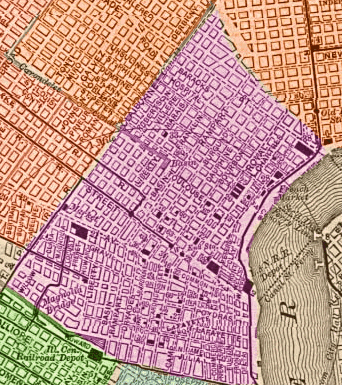

Vieux Carre
 In 1682, a French explorer named Cavalier de la Salle came upon a piece of high land near the Mississippi river where Indians had lived for centuries. He planted a cross in their settlement and claimed it for the King of France. In 1718, Jean Baptiste le Moyne , sieur de Bienville founded the city of New Orleans at this spot. The city developed slowly because of the swamps and vegetation, but once it was cleared and drained, the new city was laid out in a grid pattern with the Place d'Armes (Jackson Square) occupying the center portion of the town facing the levee. The Place d'Armes was a military parade ground in the eighteenth century.
In 1682, a French explorer named Cavalier de la Salle came upon a piece of high land near the Mississippi river where Indians had lived for centuries. He planted a cross in their settlement and claimed it for the King of France. In 1718, Jean Baptiste le Moyne , sieur de Bienville founded the city of New Orleans at this spot. The city developed slowly because of the swamps and vegetation, but once it was cleared and drained, the new city was laid out in a grid pattern with the Place d'Armes (Jackson Square) occupying the center portion of the town facing the levee. The Place d'Armes was a military parade ground in the eighteenth century.
The street names, most of which have remained the same since being laid out, reflect the great deference the French paid to their nobility at that time. Chartres , Bourbon, Burgundy , Conti, Toulouse and Dumaine were all titles of the sons or sons-in-law of King Louis XIV. St. Louis Street honored the king; St. Philip Street honored his brother Philip and Orleans Street was his family name. Iberville Street was named for Pierre Le Moyne sieur d'Iberville who colonized the Mississippi Gulf Coast for Louis XIV.
Early architecture in New Orleans was crude. In 1727, a church was built on the site of the present St. Louis Cathedral. The church of brick and wood was destroyed in the fire of 1788. The fire, which happened on Good Friday, destroyed over 800 structures – most of the French Quarter at that time. The extent of the damage was due in part to the priests' refusal to sound the alarm of fire by ringing the church bells on Good Friday.
In 1794, a second fire swept through the French Quarter destroying over 200 buildings this time.
St. Louis Cathedral was completed in 1795 and is still standing today. The Ursuline Convent on Chartres Street was built in 1734. It reflects the French architectural style of that period. One of the early developers in the city was Don Andres Almonaster y Roxas , who came to Louisiana when Spain gained control of the area in 1763. About 1770, Almonaster built retail blocks on the east and west sides of the Place d'Armes. The development became a popular shopping area. In 1795, the Cabildo was erected next to St. Louis Cathedral to house the colony's Spanish government. In 1815, the Presbytere was built on the opposite side of the St. Louis Cathedral. It is a twin to the Cabildo.
Early 19th century architecture in New Orleans featured Creole Cottages and Spanish/French colonial homes with balconies and central courtyards. Most buildings were stuccoed. Place d'Armes became Jackson Square in honor of Andrew Jackson.
Almonaster's daughter, Baroness Micaela de Pontalba built her rowhouses flanking Jackson Square on the east and west in 1850. These elegant residences brought renewed popularity to the French Quarter, which had lost some of its status to the Garden District and other developing suburbs.
Many small operations here advertise in the Blue Book, the most famous being the establishment at 826 St. Louis St . belonging to Marianne LeSoleil Levant.
